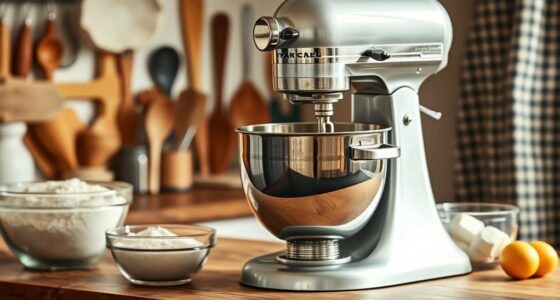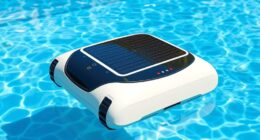The rise of home espresso machines happened as technological advances, like electric pumps and digital controls, made café-quality brewing easier and more accessible. Italian innovations laid the foundation, while modern designs focus on ease of use, consistency, and customization. Consumer preferences shifted toward user-friendly features and sustainable options, boosting the market. If you’re curious about how these machines evolved from luxury items to everyday essentials, there’s much more to discover.
Key Takeaways
- Technological innovations like electric pumps and digital controls made espresso machines more user-friendly for home use.
- The shift from manual lever to semi-automatic and fully automatic models simplified brewing processes.
- Consumer demand for café-quality coffee at home increased post-pandemic, boosting at-home espresso machine popularity.
- Modern machines offer multiple brewing modes, app connectivity, and easy maintenance, appealing to a broad user base.
- Italian design legacy and sustainability focus have driven market growth and technological advancements in home espresso equipment.
The Origins and Early Development of Espresso Machines

The history of espresso machines begins in 1884 when Angelo Moriondo patented the first device in Turin, Italy, laying the groundwork for modern espresso brewing. This patented espresso machine marked the start of the early development in coffee technology, inspiring manufacturers to improve the brewing process. Moriondo’s invention was a significant step forward, but it was Desiderio Pavoni who later purchased Bezzera’s patents and popularized espresso machines, introducing key innovations like the pressure release valve and steam wand. These advancements made espresso faster and more consistent, transforming it into a preferred method for quick, quality coffee. The evolution of the brewing process and the contributions of early pioneers laid the foundation for the sophisticated machines we enjoy today. Additionally, the adoption of vintage decor in the design of early espresso machines helped communicate their artisanal quality and craftsmanship to consumers.
Pioneers and Innovations in 20th Century Coffee Technology
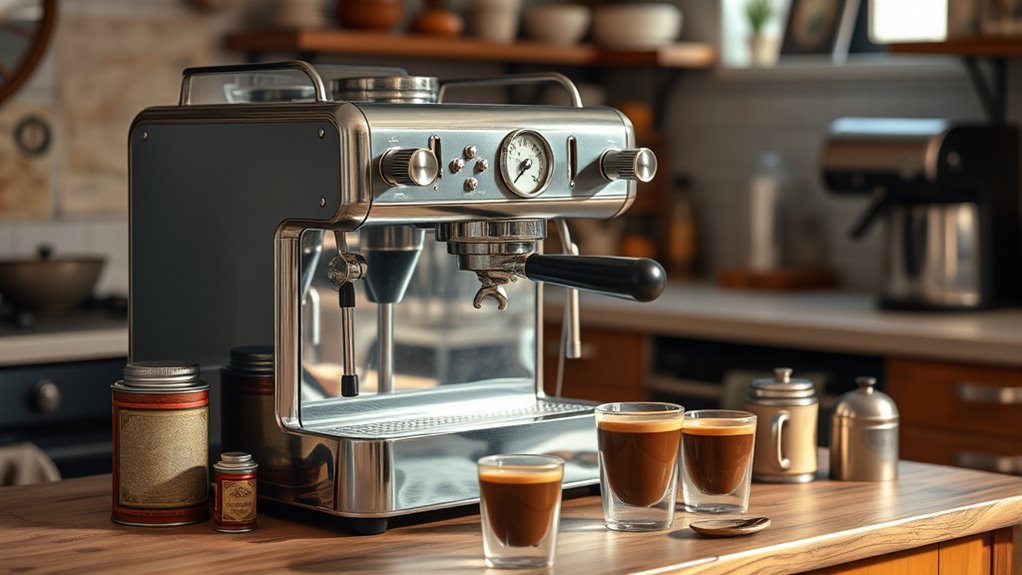
Building on the foundational innovations of early espresso machines, the 20th century saw rapid advancements driven by pioneering inventors. These innovations transformed the industry and enabled home espresso enthusiasts to access professional-quality machines. Giovanni Gaggia’s lever machine in the 1930s introduced high pressure (8-10 bars), creating rich crema. Ernesto Valente’s development of the pump around 1950 standardized water pressure, revolutionizing espresso technology. The following table highlights key figures and their contributions:
| Inventor | Innovation |
|---|---|
| Angelo Moriondo | Patented first espresso machine in 1884 |
| Luigi Bezzera | Improved features like portafilter, single-shot espresso |
| Desiderio Pavoni | Commercial machine with pressure release valve, steam wand |
| Giovanni Gaggia | Lever machine with high-pressure capability, crema formation |
These pioneers laid the groundwork for today’s home espresso machines, shaping how coffee enthusiasts enjoy their brew. The evolution of espresso technology continues to influence modern designs and brewing techniques.
Transition From Manual to Semi-Automatic and Automatic Machines

As espresso machines evolved, they became much easier to operate, reducing the skill needed to brew a good shot. Semi-automatic and automatic models offer more consistency and control, letting you customize your coffee without hassle. This shift has made home brewing more accessible for everyone, from beginners to enthusiasts. Additionally, modern machines often feature easy-to-clean designs, simplifying maintenance and encouraging consistent use. The integration of user-friendly interfaces further enhances the experience, making it simpler for anyone to enjoy high-quality espresso at home.
Ease of Operation
Moving from manual lever espresso machines to semi-automatic models in the 1960s marked a significant step toward making espresso brewing easier. These machines introduced electric pumps and simplified controls, reducing the skill needed to produce quality espresso. Today’s automatic and super-automatic machines take ease of use further, offering a user-friendly interface and digital controls that streamline the brewing process. With features like one-touch operation, you can enjoy home espresso without hassle. Imagine:
- Effortlessly brewing with just a press of a button
- Precise control at your fingertips
- No need for complex techniques
- Consistent, barista-quality results
- Making coffee at home more accessible than ever
These advancements make brewing simple, so you can savor your favorite espresso without stress.
Consistency and Control
The shift from manual lever machines to semi-automatic and automatic models has greatly improved espresso consistency and control. With programmable settings, you can easily fine-tune brewing variables like shot volume, pressure, and temperature, guaranteeing each cup matches your preferences. Modern machines incorporate digital interfaces and app connectivity, giving you precise control over variables such as temperature regulation and brew time. Electronic pumps and PID temperature controls introduced in the 1970s and 1980s enhanced consistency, making your espresso more reliable. Today’s automatic and super-automatic machines handle grinding, tamping, and brewing, allowing you to customize variables for ideal results. This combination of advanced control and customization ensures that every shot is consistent, giving you café-quality espresso at home. Additionally, vetted technology in home machines ensures durability and reliability for everyday use.
The Impact of Mechanical and Electronic Advancements on Home Brewing

Mechanical and electronic advancements have profoundly transformed home espresso brewing, making professional-grade results more attainable. With innovations like the electric pump, you now get consistent pressure at around 9 bar, ensuring every shot is perfect. Modern machines with pressure control and PID controllers let you fine-tune temperature and extraction, boosting flavor. Dual boilers separate brewing and steaming, giving you precise control over each process. Electronic controls and digital interfaces simplify complex adjustments, so you can focus on brewing. Smart technology, including app control and programmable settings, elevates your home brewing experience. Additionally, Mazda Tuning techniques such as engine tuning and performance upgrades have influenced the evolution of home brewing technology, emphasizing precision and customization. Improved pressure regulation systems further enhance consistency and flavor extraction in home espresso machines—AI-driven safety features are also being integrated to prevent malfunctions and ensure reliable operation. For instance, the integration of advanced control systems allows for more consistent temperature and pressure management, directly impacting brew quality. Feel confident knowing your machine delivers perfect pressure every time – Experience the joy of precise temperature control for richer flavors – Enjoy seamless switching between brewing and steaming – Customize your brew with just a tap or app command – Bring professional-level automation into your kitchen. Additionally, incorporating preventative maintenance features helps extend the lifespan of your machine and maintain optimal performance.
Cultural Significance and Italy’s Role in Espresso Innovation

Italy’s rich tradition of craftsmanship and innovation has shaped the world of espresso in profound ways. Italy is widely regarded as the birthplace of espresso, with pioneers like Angelo Moriondo and Giovanni Gaggia leading early innovations that transformed coffee culture globally. Italian craftsmanship and design principles influence modern espresso machines, balancing aesthetics with brewing precision. The caffè culture, especially in cities like Milan and Rome, elevates espresso to a social ritual and symbol of national identity. Italy’s focus on technological innovation, such as the pump-driven espresso machine in the 1960s, revolutionized both commercial and home brewing. Iconic Italian companies like La Marzocco and Faema continue to lead in espresso machine design, cementing Italy’s legacy in espresso innovation and global coffee culture.
The Modern Home Coffee Market and Consumer Trends

You’re likely noticing more high-tech, versatile espresso machines at home, driven by increasing demand for quality and convenience. Consumer preferences now favor user-friendly features, app control, and sustainable options that fit busy lifestyles. As the market expands, technological innovations continue to shape how you enjoy your coffee experience. Additionally, incorporating advanced technology such as digital controls and smart connectivity enhances overall user satisfaction and performance. Ensuring that these machines meet trustworthiness standards is essential for long-term reliability and safety. Incorporating features like energy efficiency can also appeal to environmentally-conscious consumers seeking sustainable brewing solutions. Moreover, the integration of skilled craftsmanship with innovative designs ensures a balance between tradition and modernity in home espresso machines. This blend of modern innovation and craftsmanship helps maintain high-quality standards that consumers trust and appreciate.
Market Growth Drivers
The modern home coffee market is experiencing rapid growth, fueled by consumers’ desire for café-quality beverages without leaving their homes. This surge in market growth is driven by increased consumer demand for high-quality coffee at home, supported by the rise of advanced features in espresso machines and multi-method brewing devices. As more people embrace home brewing, they seek versatile equipment that offers greater control and customization. The market expansion is also propelled by the pandemic, which encouraged investments in home coffee setups to replicate café experiences. You can feel the excitement in this shift, with:
- The thrill of mastering sophisticated brewing techniques
- The convenience of brewing your favorite coffee anytime
- The pride in crafting barista-quality drinks at home
- The joy of exploring specialty coffee education
- The satisfaction of being part of a growing community of coffee enthusiasts
- The integration of smart technology in modern espresso machines enhances user experience and personalization. Additionally, innovations in home brewing technology are making professional-level coffee more accessible to everyday consumers. The increasing availability of state-specific tax advantages for home coffee equipment underscores the broader trend of customization in personal finance and lifestyle choices. Furthermore, the emphasis on space-efficient appliances aligns with modern homeowners’ focus on maximizing limited kitchen areas. Moreover, the rise of specialty coffee culture encourages consumers to invest in higher-quality equipment to enjoy unique flavor profiles at home.
Technological Innovations
Advancements in technology have dramatically transformed home espresso machines, making professional-quality brewing more accessible than ever. Electric pumps, introduced in the 1960s like the E61 system, enable consistent 9-bar pressure, essential for great espresso. Modern machines feature precise pressure control and PID temperature regulation, ensuring ideal extraction and flavor. Dual boilers allow simultaneous brewing and steaming, enhancing efficiency. App connectivity offers remote control and customization, giving you greater convenience. Consumers now prefer semi-automatic models for control or super-automatic machines for ease of use, while multi-method machines provide versatility by adjusting variables like temperature and extraction method. Pump technology has been pivotal in achieving consistent pressure and extraction quality. These technological innovations have fueled the surge in home espresso popularity, transforming how coffee enthusiasts craft their favorite beverages at home.
Consumer Preferences
- Precise temperature and pressure control for perfect extraction, ensuring consistent quality in every cup.
- App-controlled brewing for convenience and customization, allowing users to tailor their coffee experience seamlessly.
- Multi-method brewing to explore different coffee styles, catering to a variety of taste preferences.
- Consistent results to enjoy café-quality drinks daily, which is supported by user-friendly interfaces that simplify operation.
- Stylish designs that enhance home aesthetics, making the machine a centerpiece in modern kitchens.
- Incorporating investment security measures ensures long-term value and reliability of your espresso setup, especially when choosing durable components and reputable brands.
Technological Features Shaping Today’s Espresso Machines
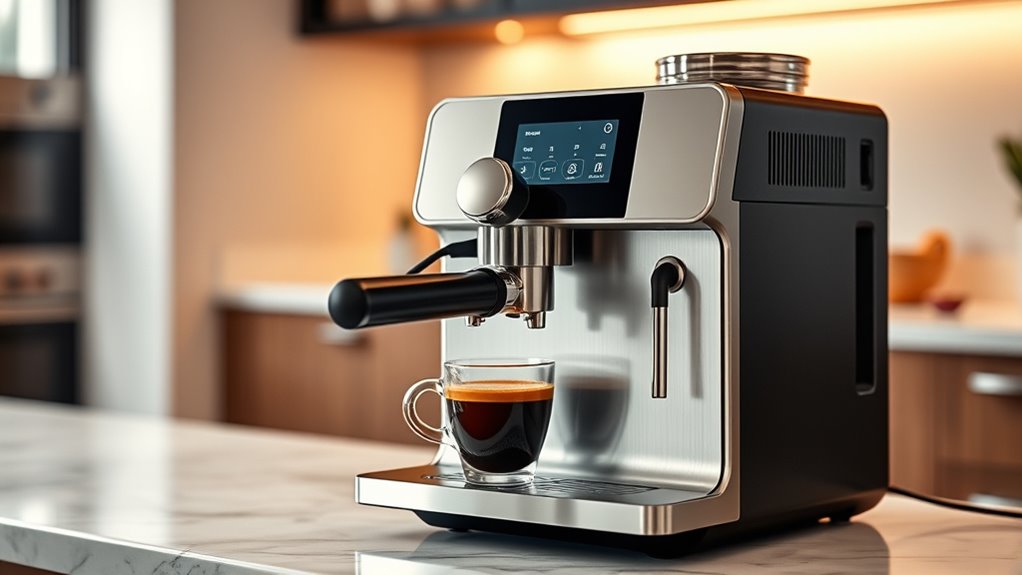
Modern espresso machines incorporate a range of technological features that markedly enhance brewing precision and convenience. Electric pumps typically operate at 9 bar pressure, ensuring ideal extraction and rich crema. Advanced temperature control with pID systems allows you to fine-tune water temperature for consistent flavor. Many machines offer automatic, programmable shot timing and pre-infusion, making brewing more precise and effortless. Some models include multi-method capabilities, so you can switch easily between espresso, cold brew, and other extraction styles. Digital interfaces and smartphone app integration give you full control over brewing variables, allowing customization and remote operation. These innovations make it easier to achieve professional-quality results at home, elevating your espresso experience with reliable consistency and user-friendly features.
Evolving Consumer Preferences for Control and Customization
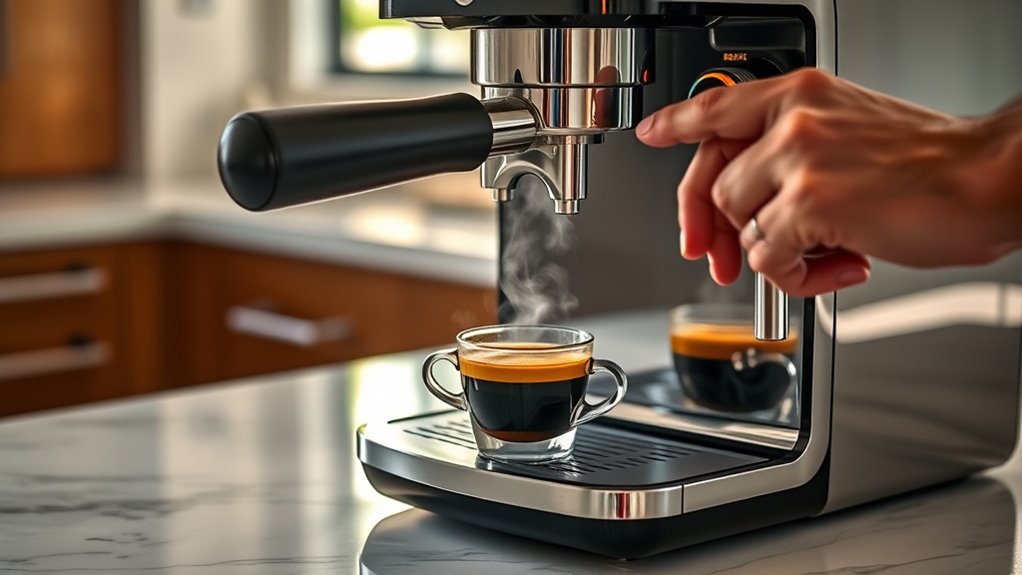
As technology continues to evolve, consumers increasingly seek more control over their espresso brewing process. You want personalized coffee experiences that reflect your unique preferences, from brew temperature to extraction time. Modern machines offer adjustable settings for grind size, dose, and shot timing, empowering you to craft custom brews like a home barista. The rise of connected apps further enhances control, letting you tweak brew variables remotely for perfect results every time. Your passion for coffee drives demand for features that enable:
- Personalization of every shot
- Precise control over brew variables
- Custom brewing tailored to your taste
- Adjustable settings for ultimate flexibility
- Seamless integration via connected apps
This shift signifies a desire for more meaningful engagement with your coffee, turning brewing into an art form.
The Future of At-Home Coffee: Innovations and Market Growth
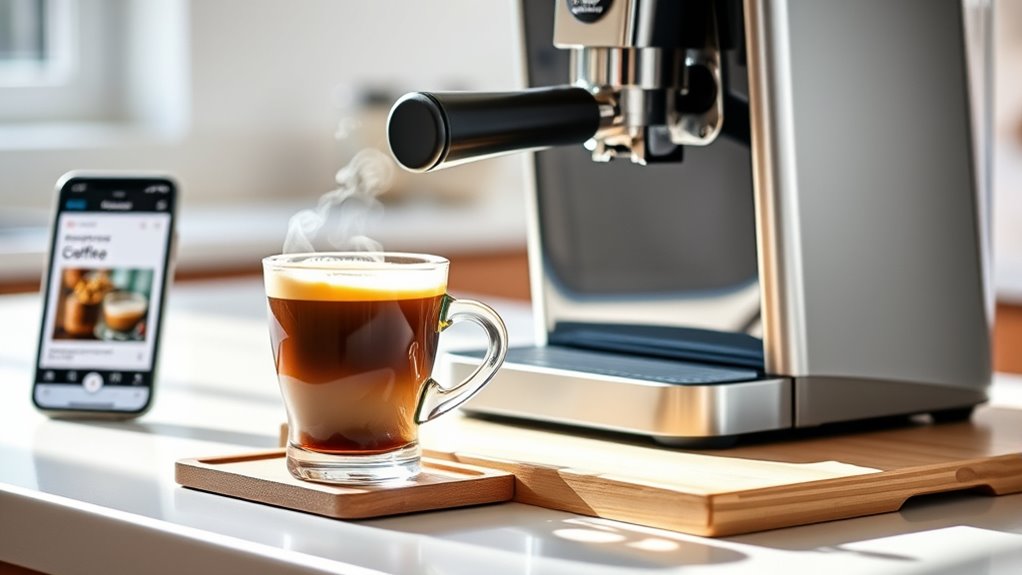
The at-home coffee market is experiencing rapid growth driven by consumer desire for high-quality, cafe-style beverages and ongoing technological innovations. As a result, home espresso and other coffee machines with advanced features are becoming more popular, fueling market growth. Innovations like multi-method machines, app-controlled options, and precise adjustments allow you to customize brew temperature, pressure, and extraction, making home brewing more versatile. Consumers are drawn to premium, space-efficient models like the KUKU Maker, which offers multiple extraction modes. Over 82% of people continue to enjoy coffee at home post-pandemic, increasing demand for appliances that deliver professional results effortlessly. Sustainability is also shaping the future, with manufacturers developing energy-efficient, recyclable coffee machines to meet eco-conscious consumer demand.
Frequently Asked Questions
How Did Espresso Become Popular?
You might wonder how espresso became popular. It started in Italy in the early 20th century, thanks to Luigi Bezzera’s invention, making quick, concentrated coffee accessible. Gaggia’s pump-driven machines in the 1930s boosted its appeal with rich crema. Post-WWII innovations improved consistency, and the global influence of Italian culture, along with coffee shops and media, spread espresso worldwide, turning it into a symbol of sophistication and quality.
Why Do People Buy Espresso Machines?
Did you know over 84% of coffee drinkers made coffee at home in 2022? You buy espresso machines because they let you craft café-quality drinks right in your kitchen. Advances in technology make brewing easier and more consistent, so you can enjoy personalized coffee experiences. Whether you’re a novice or a seasoned enthusiast, owning an espresso machine gives you greater control and convenience, making your daily coffee routine more enjoyable.
What Is the History of the E61 Espresso Machine?
You’re curious about the history of the E61 espresso machine. Developed in 1961 by La Marzocco, it revolutionized espresso brewing with its innovative saturated group head and electric pump, ensuring consistent pressure and temperature. Its thermosyphon system kept the brew temperature stable, setting new industry standards. This groundbreaking design influenced modern machines and remains a symbol of technological innovation and craftsmanship in coffee brewing today.
What Is the History of the Espresso Coffee Machine?
You’re curious about the history of the espresso coffee machine. It all started in 1884 when Angelo Moriondo patented the first espresso machine, laying the foundation. Luigi Bezzera then improved it in the early 1900s with innovations like the portafilter. Over the years, inventors like Pavoni and Gaggia made key advancements, culminating in electric pumps in the 1950s, transforming espresso brewing into what we enjoy today.
Conclusion
As you embrace the world of at-home espresso, you’re stepping into a rich tapestry woven with innovation and tradition. Just like a skilled barista’s touch transforms beans into art, today’s machines turn your kitchen into a coffee haven. The future promises even brighter horizons, where technology and passion blend seamlessly. So, grab your machine and imagine—each sip a masterpiece, crafted by your hands in the symphony of your daily routine.


